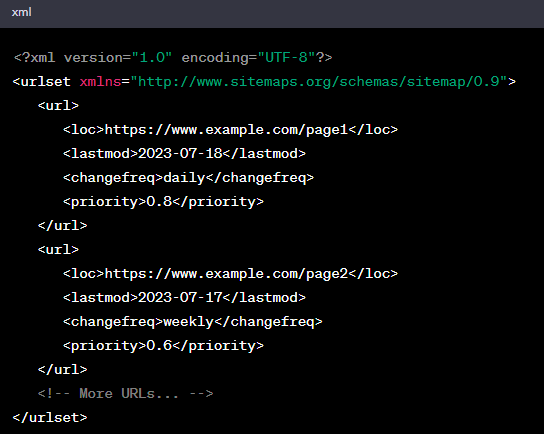An XML sitemap is a file that lists all the pages and content on a website in a structured format using XML (Extensible Markup Language). It serves as a roadmap for search engines to discover and index the content on a website more effectively. XML sitemaps are especially useful for websites with large or complex structures, new websites, or sites with dynamic content that might not be easily discovered through regular crawling.
The XML sitemap provides information to search engine crawlers, informing them about the organization of the website’s content, the relationship between different pages, and the last time each page was updated. This information helps search engines better understand the website’s structure and prioritize which pages to crawl and index.
Key elements of an XML sitemap include:
- URLs: The list of URLs (web page addresses) of the content on the website.
- Last Modified: The date and time when each URL was last modified or updated.
- Change Frequency: An indication of how often the content on each URL is likely to change (e.g., hourly, daily, weekly, monthly, never).
- Priority: A priority value indicating the importance of each URL relative to other URLs on the website. The priority ranges from 0.0 to 1.0, with 1.0 being the highest priority.
Example of a simple XML sitemap:
<?xml version="1.0" encoding="UTF-8"?>
<urlset xmlns="http://www.sitemaps.org/schemas/sitemap/0.9">
<url>
<loc>https://www.example.com/page1</loc>
<lastmod>2023-07-18</lastmod>
<changefreq>daily</changefreq>
<priority>0.8</priority>
</url>
<url>
<loc>https://www.example.com/page2</loc>
<lastmod>2023-07-17</lastmod>
<changefreq>weekly</changefreq>
<priority>0.6</priority>
</url>
<!-- More URLs... -->
</urlset>
Once created, the XML sitemap should be submitted to search engines, such as Google, Bing, or Yahoo, through their webmaster tools or search console. This allows search engines to efficiently crawl and index the website’s pages, improving the chances of the content being found and displayed in search engine results pages (SERPs).
It’s important to note that while XML sitemaps are helpful for SEO (Search Engine Optimization) and website indexing, they do not directly impact a website’s search rankings. However, they do contribute to ensuring that search engines can find and index all relevant content, which can indirectly benefit SEO efforts.
- Free SEO Toolkit: How to Boost Your Website Rankings with Zero Budget - June 7, 2025
- What Are UTM Parameters? A Human-Friendly Guide to Tracking Your Traffic - May 7, 2025
- How to Build a GoHighLevel Funnel: A Step-by-Step Guide - February 13, 2025
